#Lynda Cowell
Explore tagged Tumblr posts
Photo

And the Reading List Goes to: Pivotal Oscar Moments The Academy Awards aren’t just about recognition — they’re about an ever-evolving industry in an ever-evolving society. https://longreads.com/2023/03/02/and-the-reading-list-goes-to-pivotal-oscar-moments/
#Events#Reading List#David Crow#Den of Geek#Dina Gilio Whitaker#Girls on Tops#Gone with the Wind#Kathryn Bigelow#Koraljka Suton#Lynda Cowell#Manohla Dargis#Midnight Cowboy#NeoText#Oscars#red carpet#Sacheen Littlefeather#Saving Private Ryan#The Conversation#The New York Times#Elizabeth Blackwell#Longreads
0 notes
Text
The Life and Crimes of Ted Bundy: A Detailed Timeline
By Maya Mehta, Seattle University Class of 2025
August 13, 2024

When one hears the name Ted Bundy, two things immediately spring to mind: intimidating and dishonest. Because of this case, he became one of the most well-known serial killers in American history, and a lot of books, documentaries, and movies were made on his life and murders. This is a terrifying story of Ted Bundy’s trip into the dark world of madness where he played on people’s weaknesses by fooling them with charm and wreaking havoc wherever he went. This article gives a detailed account of Ted Bundy’s life right from birth till his death.
Early Life (1946-1968)
November 24th, 1946: Eleanor Louise Cowell gave birth to Theodor Robert Cowell, also known as Ted Bundy, in Burlington, Vermont. No information is available about his father. Ted was raised by his maternal grandparents, therefore for a considerable portion of his early years, he thought of his mother as his sister.
1950: Louise relocated with her son to Tacoma (Washington) and married Johnny Bundy. However, there was no strong relationship between him and her.
1965: He graduated from Woodrow Wilson High School in Tacoma. According to others, this young man had good manners, intelligence as well as great prospects.
1967: Bundy began attending the University of Washington, where he met Stephanie Brooks, a woman who played a significant role in his life. Their relationship ended in 1968, which deeply affected Bundy and marked the beginning of his downward spiral.
Early Criminal Activities and First Arrests (1969-1974)
1969: Bundy’s graduation from the University of Washington marked 1969 with a degree in psychology. He held down several positions including a crisis hotline center where he met and became friends with Ann Rule, who later penned Bundy’s biography.
1971: Bundy signed up for law school but didn’t do well. It was during this time that he started dating Elizabeth Kloepfer, an unsuspecting single mom.
1974: There was a huge increase in the magnitude of Bundy’s criminal activities. He began abducting and killing young women in Washington and Oregon. The victims were mostly look-alikes of Stephanie Brooks, having long dark hair parted down the middle.
The Murders Intensify (1974-1975)
January 4, 1974: Karen Sparks was attacked and taken hostage by Bundy, a University of Washington student. She lived but was seriously injured and permanently brain damaged.
February 1, 1974: Another University of Washington student called Lynda Ann Healy went missing from her apartment. Her remains were discovered later in the Taylor Mountain area.
Spring-Summer 1974: Bundy performed more abductions resulting in murders such as Georgann Hawkins, Brenda Carol Ball, Roberta Kathleen Parks, Susan Elaine Rancourt, and Donna Gail Manson.
July 14, 1974: Bundy abducted Janice Ott as well as Denise Naslund from Lake Sammamish State Park. A handsome young man with a broken arm who introduced himself as “Ted” according to eyewitnesses.
August 1974: He relocated to Salt Lake City for his law studies at the University of Utah. He continued his killing spree across Utah, Colorado and Idaho.
Arrests and Escapes (1975-1977)
August 16, 1975: Bundy was arrested in Granger, Utah for failure to stop at a police officer. His car was searched, and burglary tools, handcuffs and other suspect items found. He was linked with the DaRonch kidnapping and subsequently charged.
February 1976: He was convicted of Carol DaRonch’s abduction and sentenced to serve between one and fifteen years in prison in Utah State. In addition to this, he was also associated with Colorado cases involving numerous murders.
June 7, 1977: Bundy escaped from the Pitkin County Courthouse Law Library via jumping out of a second-floor windowpane located at Aspen Colorado. He was re-arrested after eight days.
December 30, 1977: Bundy escaped again this time from Garfield County Jail Glenwood Springs Colorado. He made his way to Florida where he left behind death trails.
The Florida Murders and Final Capture (1978-1979)
January 15, 1978: Bundy broke into Florida State University’s Chi Omega sorority house. He murdered Margaret Bowman and Lisa Levy in a brutal attack on four individuals and critically injured Karen Chandler and Kathy Kleiner.
February 9, 1978: Bundy kidnapped and later killed a twelve-year-old girl called Kimberly Leach in Lake City, Florida. Her corpse was discovered two months later at a state park.
February 15, 1978: Finally, Bundy was apprehended in Pensacola after he was pulled over by a police officer. He gave false identification but the FBI’s most wanted fugitive was finally revealed.
July 1979: The trial for the Chi Omega murders took place. He acted as his own attorney despite overwhelming evidence against him; hence he was found guilty of all charges. The sentence passed on him was death penalty.
Appeals, Confessions, and Execution (1980-1989)
Bundy was tried for the murder of Kimberly Leach in January 1980 and received a second death sentence.
At that time, Bundy had been on death row since 1979. It was during this period that he started confessing to many murders across states.
By this time, he had exhausted all appeals available to him. On January 24, 1989, Ted Bundy died in an electric chair at Florida State Prison.
Sentence one: In January 1980, Bundy stood trial for the murder of Kimberly Leach and was sentenced to death for a second time. Within the course of his trial, however, he married Carole Ann Boone who believed him to be innocent and stood by his side until the confessions were made.
Sentence two: While on death’s row in 1984, Bundy began making confessions about numerous murders he committed across different states which helped bring closure to some families while revealing the full extent of his cruelness.
Sentence three: Finally exhausting all legal resources available to him and so on January 24th, 1989 Ted Bundy faced electric chair at Florida State Prison.
Legacy and Impact
Ted Bundy’s heinous acts significantly affected the American culture and criminal justice system. He was able to elude capture and manipulate the legal process that highlighted fundamental problems within the judiciary and law enforcement systems. Additionally, his case led to new investigative techniques and increased public awareness about serial killers.
Psychological Profile: Criminologists and psychologists have deeply investigated this case of Bundy. His friendly disposition contradicted his violent nature, thereby making him a typical psychopathic person.
Media Attention: The first nationally televised trials were held for Bundy which ended up receiving significant media attention across America. That his life has been documented in countless books, films, documentaries is clear evidence that people just cannot let go of this story.
Victim Advocacy: Many people became aware of what happened to Bundy’s victims because of these atrocities. Quite a number later turned into victim rights activists calling for reforms in the criminal justice system to protect the vulnerable as well as help those who get affected by violent crimes.
Ted Bundy’s life and actions offer a terrible reminder of the evil that lies within human beings. Shocking citizens of the country, who never thought he could have done such evil things, due to his constant association with them. While Ted Bundy was executed to end his reign of terror, people who came across him during his horrific acts are still affected by this experience. Thus, understanding his timeline not only honors those who were killed but also reminds us about vigilance and evolution of our justice system.
______________________________________________________________
Canning, Kristin. “Here’s a Complete Timeline of All the Crimes Ted Bundy Committed.” Women’s Health, Women’s Health, 10 May 2019, www.womenshealthmag.com/life/a27435103/ted-bundy-crimes-timeline/. Accessed 10 Aug. 2024.
INSIDER. “The Full Timeline of Ted Bundy’s Murders.” Business Insider, Insider, Feb. 2019, www.businessinsider.com/the-full-timeline-of-ted-bundys-murders-2019-2. Accessed 10 Aug. 2024.
Paige, Rachel. “A Full Timeline of Ted Bundy’s Crimes, Starting at Age 14.” Refinery29.com, Refinery29, 4 May 2019, www.refinery29.com/en-us/2019/01/222438/ted-bundy-timeline-murders. Accessed 10 Aug. 2024.
“Ted Bundy Killings: A Timeline of His Twisted Reign of Terror.” Biography, Biography, 12 Aug. 2021, www.biography.com/crime/ted-bundy-timeline-murders. Accessed 10 Aug. 2024.
Yang, Allie, et al. “Timeline of Many of Ted Bundy’s Brutal Crimes.” ABC News, ABC News, 15 Feb. 2019, abcnews.go.com/US/timeline-ted-bundys-brutal-crimes/story?id=61077236. Accessed 10 Aug. 2024.
0 notes
Text
Ted Bundy
Ted Bundy, born Theodore Robert Cowell on November 24, 1946, was one of the most notorious American serial killers. He is known to have kidnapped, raped and killed at least 36 young women in 1970s and probably earlier. He was executed in the electric chair in 1989. His murders have inspired many novels and films about serial killers.

Photo of Ted Bundy
His mother was Eleanor Louise Cowell, who was 22 years old and unmarried when she gave birth to Bundy. His biological father's identity may never be confirmed, since on his birth certificate the father was listed as unknown; also, some rumours identify his father as his grandfather. For the first three years of his life, Bundy lived with his maternal grandparents and was told that his mother was his sister. He eventually discovered the truth and expressed a lifelong resentment toward his mother for never talking to him about his true parentage. In 1951 Louise met and married Johnny Culpepper Bundy, a hospital cook, and later that year the couple officially adopted Bundy, that took his name. He had a tense relationship with his stepfather, and complained to his girlfriend that Johnny "wasn't very bright” and "didn't make much money".
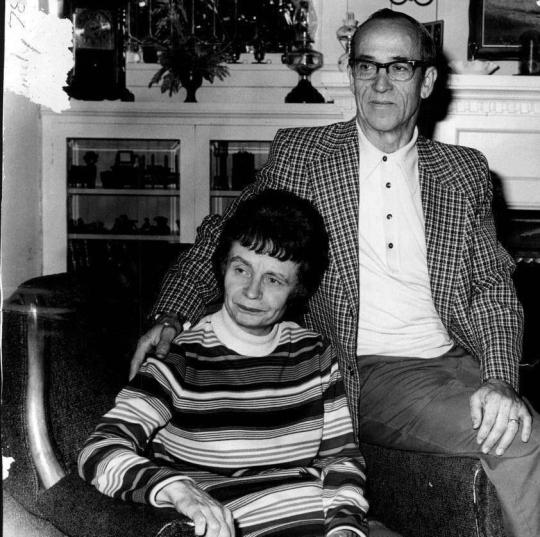
Ted Bundy’s parents, Eleanor Louise Cowell and Johnny Culpepper Bundy
After graduating from high school in 1965, Bundy attended the University of Puget Sound for one year before transferring to the University of Washington. There, he fell in love with Stephanie Brooks, a wealthy and lovely young woman from California. He was devastated by their breakup, and many of his following victims resembled his college girlfriend. He graduated from the University of Washington with a degree in psychology in 1972.
Attacks and murders
There is no consensus on when or where Bundy began killing women. He told different stories to different people and refused to reveal the specifics of his first crimes. For example, he told his mother that he attempted his first kidnapping in 1969 in Ocean City, New Jersey, but did not kill anyone until 1971 in Seattle, yet told psychologist Art Norman that he had killed two women in Atlantic City in 1969.
Homicide detective Robert D. Keppel and biographer Ann Rule, who had previously worked with Bundy, both believed that he might have started killing as a teenager. Circumstantial evidence suggested that he may have kidnapped and killed eight-year-old Ann Marie Burr when he was 14 years old, but he repeatedly denied. His earliest documented homicides were committed in 1974, at the age of 27. The disappearances all took place at night, usually near ongoing construction work, and the victims were all young, attractive, and with long hair parted in the middle; at most crime scenes there were sightings of a man wearing a cast or a sling, and driving a brown or tan Volkswagen Beetle.

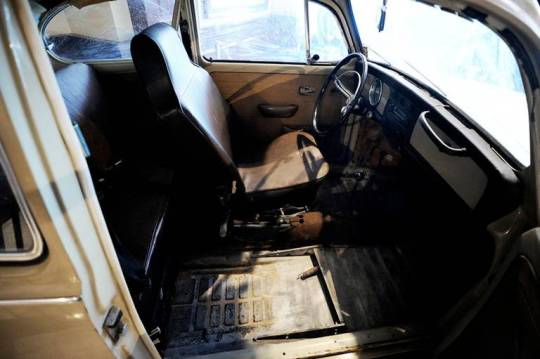
Photos of Ted Bundy's 1968 Volkswagen Beetle, in which he committed many of his crimes. The vehicle is on display at the National Museum of Crime and Punishment.
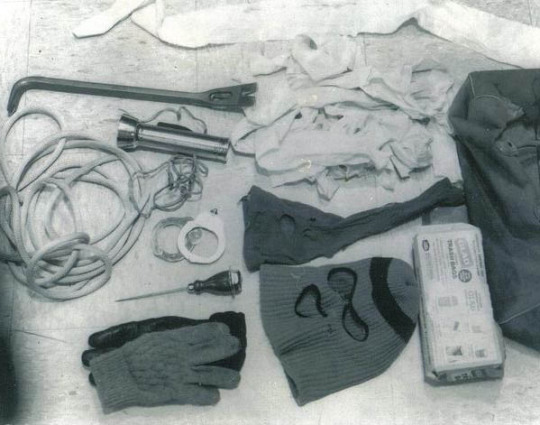
Items found in his car when he was arrested in 1975
His first confirmed attack occurred shortly after midnight on January 4, 1974, when Bundy entered the apartment of Joni Lenz. After bludgeoning her with a metal rod from her bed frame, he sexually assaulted her with either the same rod or a metal speculum. She survived, but with permanent physical and mental disabilities. In the early morning of February 1, 1974, Bundy broke into the room of Lynda Ann Healy; he beat her unconscious, dressed her in blue jeans, a white blouse, and boots, and carried her away. On March 12, Donna Gail Manson, left her dormitory to attend a jazz concert on campus, but never arrived. On April 17, Susan Elaine Rancourt disappeared while on her way to her dorm room after an advisors' meeting at Central Washington State College in Ellensburg. On May 6, Roberta Kathleen Parks left her dormitory to have coffee with her friends at the Memorial Union, but never arrived. On June 1, Brenda Carol Ball disappeared after leaving the Flame Tavern in Burien, near Seattle; she was last seen in the parking lot, talking to a brown-haired man. On June 11, UW student Georgann Hawkins disappeared while walking to her sorority house.
The murders culminated on July 14, 1974, when Bundy abducted two women, Denise Marie Naslund and Janice Anne Ott, in the daylight and from crowded areas. Five female witnesses said that a good-looking young man, who introduced himself as "Ted", asked their help to unload a sailboat from his car. Four girls refused, but one agreed and accompanied him to his car. She saw there was no sailboat and fled. Using the same story, he approached and abducted Janice Anne Ott and, approximately four hours later, Denise Marie Naslund. On September 6, 1974, two grouse hunters found the skeletal remains of the two girls near a service road in Issaquah. After these happenings, King County police disclosed a composite sketch, that was printed in regional newspapers and transmitted on local television stations. These are not the only murders that he committed, as it is believed that he has killed more than a hundred women.
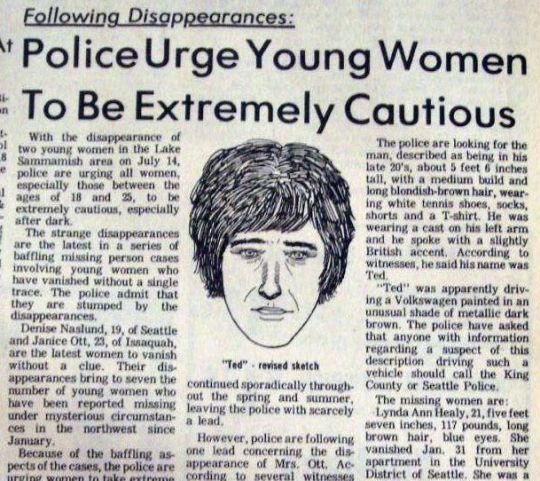
Newspaper from 1974 warning young women about “Ted”, aka Ted Bundy
Timeline of Bundy’s attacks
In 1974
Joni Lenz, age 18, survived the attack on January 4, 1974
Lynda Ann Healy, age 21, died on February 1, 1974
Donna Gail Manson, age 19, died on March 12, 1974
Susan Elaine Rancourt, age 18, died on April 17, 1974
Roberta Kathleen Parks, age 20, died on April 17, 1974
Brenda Carol Ball, age 22, died on June 1, 1974
Georgeann Hawkins, age 18, missing since June 11, 1974
Denise Marie Naslund, age 18, died on July 14, 1974
Janice Anne Ott, age 23, died on July 14, 1974
Nancy Wilcox, age 16, missing since October 2, 1974
Melissa Anne Smith, age 17, died on October 26, 1974
Laura Ann Aime, age 17, missing since October 31, 1974
Carol DaRonch, age 18, survived the attack on November 8, 1974
Debra Jean Kent, age 17, died on November 8, 1974
In 1975
Caryn Eileen Campbell, age 23, died on January 12, 1975
Julie Cunningham, age 26, died on March 15, 1975
Denise Lynn Oliverson, age 24, missing since April 6, 1975
Melanie Suzanne Cooley, age 18, died on April 15, 1975
Lynette Dawn Culver, age 12, missing since May 6, 1975
Susan Curtis, age 15, missing since June 27, 1975
In 1978
Margaret Elizabeth Bowman, age 21, died on January 15, 1978
Lisa Levy, age 20, died on January 15, 1978
Kathy Kleiner, age 20, attacked on January 15, 1978
Karen Chandler, age 22, attacked on January 15, 1978
Cheryl Thomas, age 21, attacked on January 15, 1978
Kimberly Dianne Leach, age 12, died on February 9, 1978
Arrests, last murders and death
On August 16, 1975, Utah Highway Patrol officer Bob Hayward arrested Bundy in Granger (a Salt Lake City suburb). The officer searched the car after he noticed that the front passenger seat had been removed and placed on the back seats. Inside he found a ski mask, a second mask created from pantyhose, a crowbar, handcuffs, trash bags, a rope, an ice pick, and other items. The police did not have enough evidence to detain Bundy, so he was released. Afterwards, Salt Lake City police placed him on 24-hour surveillance.

Ted Bundy's 1975 Utah mug shot
In September Bundy sold his Volkswagen Beetle to a Midvale teenager and Utah police impounded it. Inside the car, FBI technicians found hairs of Caryn Campbell, and some hair strands "microscopically indistinguishable" from those of Melissa Smith and Carol DaRonch. There was sufficient evidence to charge him with aggravated kidnapping and attempted criminal assault in the DaRonch case. Further investigation confirmed that he had not been with his girlfriend on any of the nights when the Pacific Northwest victims had vanished. In February 1976 Bundy stood trial for the DaRonch kidnapping, and after a four-day bench trial and a weekend of deliberation, he was found guilty. In June he was sentenced to 15 years in the Utah State Prison, and after a period of resistance he was transferred to Aspen in January 1977.
While in the Pitkin County Courthouse's library, in Aspen, he opened a window and jumped out, managing to run away. He was a fugitive for six days, until two police officers found him and brought him back in jail. He planned his escape a second time; he sawed a hole of about one square foot between the steel reinforcing bars in his cell's ceiling and, on the night of December 30, stacked books on his bed to simulate his body, climbed into the crawl space and escaped.
After evading, he travelled from Aspen to Tallahassee, Florida, passing from Chicago, Ann Arbor and Atlanta. There, on January 15, he attacked another five women, Margaret Bowman and Lisa Levy who died, Kathy Kleiner, Karen Chandler and Cheryl Thomas who survived. On February 8 he attacked another woman, Kimberly Dianne Leach; her partially mummified remains were found in a pig farrowing shed near Suwannee River State Park, near Lake City. He was arrested four days later by police officer David Lee for having stolen a car.

Two of Ted Bundy’s victims
After numerous trials and three death sentences, Bundy was executed at 7:16 a.m. on January 24, 1989, at the Florida State Prison in an electric chair. Outside the prison, hundres of people cheered, sang, danced and even set off fireworks. His body was cremated in Gainesville, and no public ceremony was held.
Sources:
Ted Bundy | Crimes, Death & Facts | - Britannica
Ted Bundy - Biography
Ted Bundy’s Victims - Women’sHealth
Ted Bundy - Wikipedia
65 notes
·
View notes
Text
Story of Ted Bundy
TW: execution photos, details of deaths
**a more detailed victim list will be posted later, beware of this post if you are sensitive to blood/gore/other oddities of true crime as it will have crime scene photos**
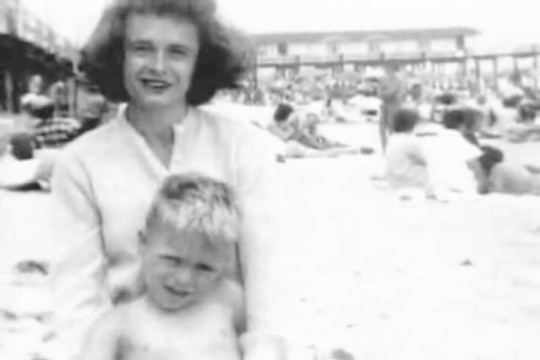
Theodore Robert Cowell, was born on November 24th, 1946 to Eleanor Louise Cowell at the Elizabeth Lund Home for Unwed Mothers. Eleanor was known by Louise and Ted’s father’s identity is unconfirmed. His birth certificate states Lloyd Marshall, a salesman and Air Force veteran, as his father. Louise claims his father to be an old war veteran known as Jack Worthington, this is who the King’s County Sheriff’s Office has listed as such. A few family members believe that Louise’s father, Samuel Cowell, could’ve been Ted’s father but no evidence has been found to support this claim.
Ted was raised in Philadelphia, Pennsylvania by his maternal grandparents for the first three years of his life. He, family, and friends, were told that his grandparents were actually his parents and that his mother was his older sister in order to protect them all from the stigma of birthing a child out of wedlock. There are variations of how Bundy found out his true parentage. A past girlfriend was told that Bundy was shown his birth certificate by a cousin, Stephen Michaud and Hugh Aynesworth (both biographers) were told by Bundy that he found the certificate himself. Anne Rule (biographer and crime writer, who knew Bundy personally) believes he did not find this information until 1969. In 1950, Louise changed her surname from Cowell to Nelson and left Philadelphia to live with cousins Alan and Jane Scott in Tacoma, Washington. In 1951, Louise met Johnny Culpepper Bundy at an adult singles night at Tacoma’s First Methodist Church. Johnny and Louise later married that year and Johnny formally adopted Ted. Johnny and Louise went on to have four children together, and whilst Johnny tried including Ted on family trips and outings, he remained distant.

Teenage Ted Bundy
In 1965, Ted graduated from Woodrow Wilson High School and enrolled in the University of Puget Sound where he spent a year before transferring to the University of Washington to study Chinese. In 1967, he became involved romantically with a UW classmate, most commonly known as Stephanie Brooks in biographies. In 1968, he dropped out of college and worked at a series of minimum wage jobs; even working as Arthur Fletcher’s bodyguard and driver during his Lieutenant Governor campaign. Brooks then ended their relationship due to Bundy’s lack of ambition. He also took one semester at Temple University after returning back to Arkansas and Philadelphia to visit family. In 1969, Ted moved back to Washington where he met Elizabeth Kloepfer (also known in Bundy literature as Liz Kendall, Beth Archer, or Meg Anders).

Ted Bundy & Elizabeth Kloepfer
In 1970, Ted re-enrolled at the University of Washington as a psychology major. During this time he became an honor student and was well regarded by his professors. In 1971, he took a job at Seattle’s Suicide Hotline Crisis Center, where he met Anne Rule who noted nothing disturbing or abnormal about Bundy. In early 1973, despite his average law school admission scores, he was granted admittance to UPS and the University of Utah. In 1973, he rekindled his relationship with Stephanie Brooks. He also continued to date Elizabeth Kloepfer. Neither woman knew of the other at this time. During this time period, Brooks had flown in several times to stay with him in Seattle. He had discussed marriage with Stephanie and had also introduced her as his fiancee at a point. In 1974, he abruptly broke off all contact. He did not return phone calls or letters. After a month of trying, Brooks was finally able to contact Bundy by phone, asking why he had so abruptly ended the relationship without an explanation. He responded with, “Stephanie, I have no idea what you mean.” and hung up the phone. She never heard from him again after that. He had just wanted to prove to himself that he could marry her in retaliation of her ending their former relationship before.
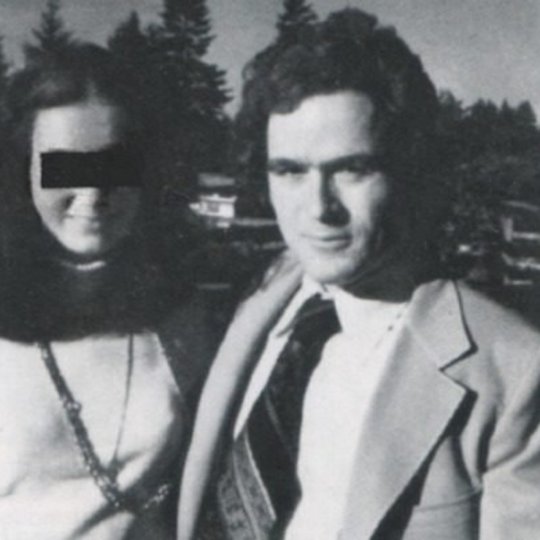
Ted Bundy and Stephanie Brooks
Ted had been skipping classes in law school by this point and had stopped attending all together by april when the first series of murders were reported. Circumstantial evidence points Ann Marie Burr, an 8-year-old girl, as one of Bundy’s first victims in 1962.
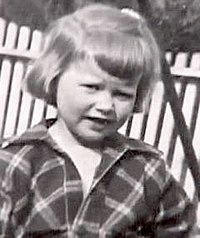
Ann Marie Burr, age 8
Washington/Oregon Murders
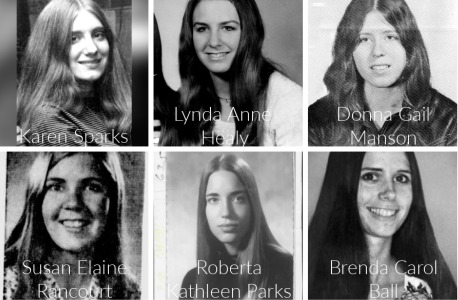

College aged young women started to disappear at a rate of about one a month in Washington and Oregon. On January 4th, 1974, shortly after midnight, Bundy snuck into the basement apartment of 18-year-old Karen Sparks (also known as Joni Lenz, Mary Adams, or Terri Caldwell in Bundy literature). He bludgeoned her with a metal rod from her bed frame and then sexually assaulted her with the same rod. She was unconscious for 10 days but survived. She sustained major permanent physical and mental disabilities. In the early morning of February 1st, 1974, Bundy broke into the basement bedroom of Lynda Anne Healy. He beat her until she was unconscious, dressed her in a white blouse, blue jeans, and boots and carried her away from the scene. On March 12th, 1974, Donna Gail Manson, a 19-year-old student at the Evergreen State College in Olympia went missing as she left her dorm to attend a jazz concert that she would never attend. April 17th, 1974, Susan Elaine Rancourt disappeared from Central Washington State College, on her way back to her dorm after an advisors meeting. Two female students later came forward with encounters with the same man. One was on the night of Susan’s disappearance and the other was three days before that. The man had his arm in a sling and had asked the girls for help loading his books into a brown or tan Volkswagen beetle. In Corvallis at Oregon State University, on May 6th, 1974, Roberta Kathleen Parks, left her dormitory to meet friends for coffee and she never arrived.
Police precincts were growing more and more concerned with each abduction. As they had no evidence or connection between each of the girls besides they were all young, attractive, college-aged, white women with their brown hair parted down the middle. On June 1st, 1974, Brenda Carol Ball, disappeared from the Flame Tavern in Burien, near the Seattle-Tacoma International Airport. She had last been seen in the parking lot with a brown-haired man with his arm in a sling. Not too long after that, on June 11th, 1974 Georgann Hawkins disappeared walking down a brightly lit alleyway between her boyfriend’s dormitory and her own sorority house. After Georgann’s disappearance was made public in the media, witnesses came forward reporting that they saw a man that night in an alley behind a nearby dormitory. He was on crutches with a leg cast and was struggling to carry a briefcase. Another witness had said that the man actually asked for her help. At this time Ted was working in Olympia as the Assistant Director of the Seattle Crime Prevention Advisory Commission. He wrote pamphlets for women on rape prevention here. He also later worked at the Department of Emergency Services (DES), which helped look for the missing women. This is where he met Carol Anne Boone, and began dating her (as well as Elizabeth Kloepfer).
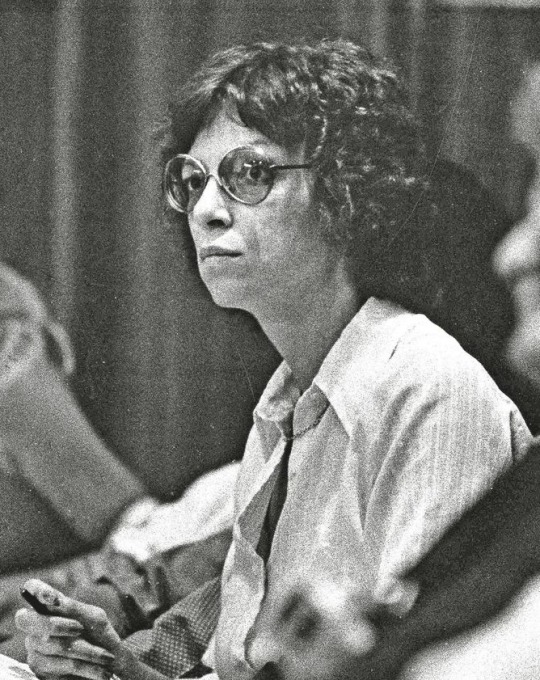
Carol Anne Boone
Pressure was immense on law enforcement at this time. This was very frustrating as panic spread through young women of the area, with six disappearances and one brutal beating. Rates of hitchhiking in young women dropped drastically. Police could not provide reporters with what little information they had because they did not want to compromise the investigation. Similarities between the victims were noted by the police in their investigations: The disappearances all took place at night, each disappearance was usually near ongoing construction work, also within a week of midterm or final exams. Every single victim was wearing slacks or blue jeans; and at most crime scenes, there were sightings of a man wearing a cast or a sling, and driving a brown or tan Volkswagen Beetle. On July 14th, 1974, five female witnesses on a beach at Lake Sammamish State Park in Issaquah, Washington, described an attractive man in a white tennis outfit with his arm in a sling. They also described him speaking in a light accent, possibly Canadian or British, and was introducing himself as Ted. He asked for their help in unloading a sailboat from his Volkswagen beetle. Four of the girls refused but one accompanied him to the point of the car in view. When she did not see a sailboat, she fled the area. Three other witnesses saw the man, now known as Ted, saw him approach Janice Ann Ott. He fed her the sailboat story and she was seen leaving the beach with him. Four hours after Janice’s disappearance, Denise Marie Naslund, vanished after leaving a picnic to use the restroom.
Idaho/Utah Murders and Kidnappings
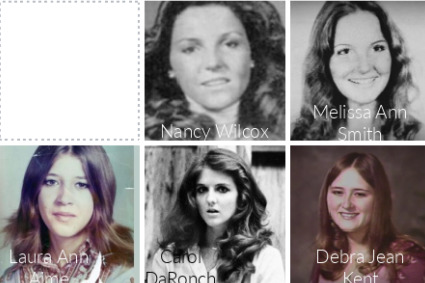
In August 1974, Ted moved to Salt Lake City, Utah, after receiving a second letter of acceptance from the University of Utah Law School. He continued to call Elizabeth Kloepfer as he lived in Salt Lake, but dated at least a dozen other women at the time. On September 2nd, 1974, Ted abducted, raped, and murdered a still unknown hitchhiker in Idaho. On October 2nd, 1974, Ted kidnapped 16-year-old Nancy Wilcox from Holladay, a suburb of Salt Lake City. On October 18th, 1974, The daughter of the police chief of Midvale, Melissa Anne Smith, vanished after leaving a pizza parlor. Her body was found nine days later, nude, in a mountainous area. Postmortem reports say she may have remained alive for up to seven days after her disappearance. On October 17th, 1974, Laura Ann Aime disappeared after leaving a cafe around midnight. Her body was found by hikers, nine miles northeast of American Fork Canyon on Thanksgiving Day. Both, Melissa and Laura had been beaten, raped, sodomized, and were strangled with nylon stockings. November 8th, 1974, Ted approached Carol DaRonch, introduced himself as Officer Roseland and used the story of someone attempting to break into her car and to accompany him to the police station to make a report. When Carol pointed out that he was not going to the police station, he immediately pulled over to the shoulder of the road and tried to handcuff her. In their struggle, he accidentally handcuffed both cuffs to the same wrist. Carol was able to throw the door open and escape because of this. On the same evening, Debra Jean Kent disappeared after leaving a theater production to pick up her brother. The school's drama teacher and a student told police that "a stranger" had asked each of them to come out to the parking lot to identify a car. Another student later saw the same man pacing in the rear of the auditorium, and the drama teacher spotted him again shortly before the end of the play. Outside of the auditorium, investigators were able to recover a key that unlocked the handcuffs on Carol DaRonch’s wrists.
In November, Elizabeth Kloepfer called King County police for the second time, after reading about the string of disappearances and murders in the towns surrounding Salt Lake. Bundy had risen considerably as a suspect among the King County Police, but the most reliable witness from Lake Sammamish could not identify in a photo lineup. In December, Elizabeth called the Salt Lake City police with her suspicions. Ted was then added to their list of suspects, but there were no credible forensic links to put him at any of the Utah crimes. In January of 1975, Ted returned to Seattle and stayed a week with Elizabeth. She did not tell him she had reported him to the police on three occasions. She also made plans to visit him in August of 1975 in Salt Lake. Unfortunately, Ted’s crimes moved to Colorado at this point.
Colorado/Utah/Idaho Murders

January 12th, 1975, Caryn Eileen Campbell disappeared walking down a well lit hallway between the elevator and her room at the Wildwood Inn in Snowmass Village, Colorado. Her body was found a month later on a dirt road next to the resort, nude. On March 15th, 1975, Julie Cunningham disappeared while walking to a dinner date with a friend from her apartment. April 6th, 1975, Denise Lynn Oliverson vanished while riding her bicycle to her parents house. Her bike and sandals were found near a railroad bridge in a viaduct. May 6th, 1975, Ted was able to lure 12-year-old Idaho native from Alameda Junior High School, Lynette Dawn Culver, to his hotel room in Salt Lake City, where he drowned and raped her. He disposed of her body in possibly the Snake river north of Pocatello. In Mid-May, three of Ted’s coworkers from DES came to stay with him for a week. This included Carol Anne Boone. They stayed for about a week. Subsequently, Ted visited Elizabeth Kloepfer in early June. They discussed getting married the following Christmas. She again made no comments about her talking to police on several occasions. Ted also did not disclose his ongoing relationship with Carol Anne Boone or his relationship with a Utah law student known as both; Kim Andrews or Sharon Auer. June 28th, 1975, Susan Curtis disappeared from the campus of Brigham Young University, forty-five miles south of Salt Lake City. In August of 1975, Ted was also baptized into The Church of Jesus Christ of Latter Day Saints although he did not follow any of the religious practices and was not an active participant in services.
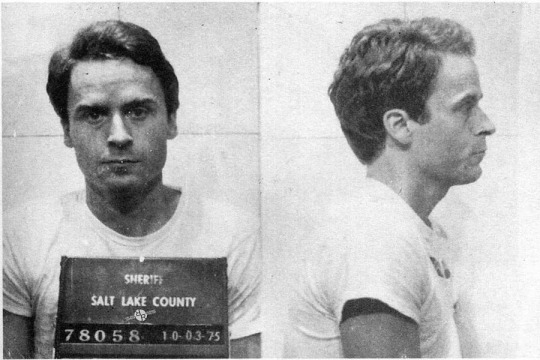
On August 16th, 1975, Officer Bob Hayward of the Utah Highway Patrol, arrested Ted in Granger. This was another suburb of Salt Lake City. Hayward had observed him cruising the residential area in the pre-dawn hours. Ted then fled the area at high speeds after seeing Hayward’s patrol car. After noticing the front passengers seat was removed and placed on the back seat, the car was searched. Hayward found a ski mask, another mask fashioned from pantyhose, a crowbar, handcuffs, trash bags, rope, an ice pick, and other burglary tools. Ted had said that the mask was for skiing, he found the handcuffs in the dumpster, and the rest were household items. Detective Jerry Thompson remembered a similar looking suspect and car description from Carol DaRonch’s attempted kidnapping. Police then searched Bundy’s apartment and were able to turn up a guide to Colorado’s ski resorts with a checkmark next to the Wildwood Inn. They were also able to find a brochure for Viewmont High School play in Bountiful where Debra Kent disappeared. They although did not find enough evidence to detain Ted and he was released on his own recognizance. Ted claimed later that investigators missed his collection of polaroid photos of his victims and he destroyed them after his release. Salt Lake police placed Ted under a 24 hour surveillance.
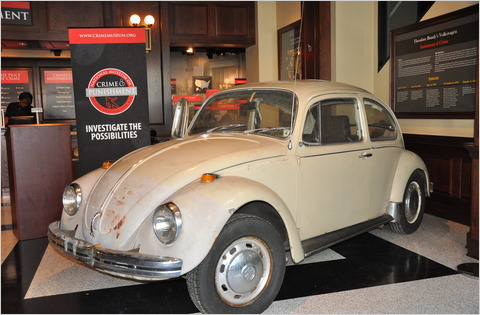

Detective Thompson flew to Seattle with two other detectives to interview Elizabeth Kloepfer. Elizabeth told them that in the year prior to Ted’s move to Salt Lake, she had discovered things that she "couldn't understand" in her house and also in Ted's apartment. The items she found included crutches, a bag of plaster of Paris that he had admitted stealing from a medical supply house, and a meat cleaver that was never used for cooking. Additional things she found included surgical gloves, an Oriental knife in a wooden case that he just kept in the glove compartment of his car, and a sack full of women's clothing. Ted was so far into debt, that Elizabeth suspected that he had stolen almost everything of significance that he owned. When she confronted him over a new TV and stereo, he warned her, "If you tell anyone, I'll break your fucking neck.” Elizabeth then mentioned that she would find Ted looking at her body with a flashlight under the covers on more than one occasion, and that he would get very upset if she mentioned cutting her hair. Which was long, brown, and parted in the middle. Detectives interviewing Elizabeth were able to confirm that Ted was not with her on any of the nights where the Pacific Northwest disappearances occurred. This is where Elizabeth learned about Stephanie Brooks and their brief engagement in 1973. In September, Ted sold his beetle to a Midvale teenager, but Utah police impounded it and dismantled it. They were able to find matching hair samples from Caryn Campbell. They also found “microscopically indistinguishable” hair strands from Melissa Smith and Carol DaRonch. On October 2nd, 1975, Police put Ted into a lineup and Carol DaRonch was able to identify him as Officer Roseland. Other witnesses were able to identify him as the stranger from the auditorium at Viewmont High School. He was able to be charged with aggravated kidnapping and attempted criminal assault in Carol DaRonch’s case. He was released on $15,000 bail, which was paid by his parents. He continued to live with Elizabeth Kloepfer during this time.
In February 1976, Ted stood trial for Carol DaRonch’s kidnapping. He waived his right to trial by jury because of the negative views surrounding the case and opted for a bench trial. After a four day trial, and a weekend of deliberation, Ted was found guilty of kidnapping and assault. In June he was sentenced to one to fifteen years in the Utah State Prison. In October, he was found hiding in bushes in the prison yard carrying an "escape kit". This included road maps, airline schedules, and a social security card. He spent several weeks in solitary confinement for this. Later in October, Colorado authorities charged him with Caryn Campbell's murder. He waived his right to extradition and was transferred to Aspen in January 1977.
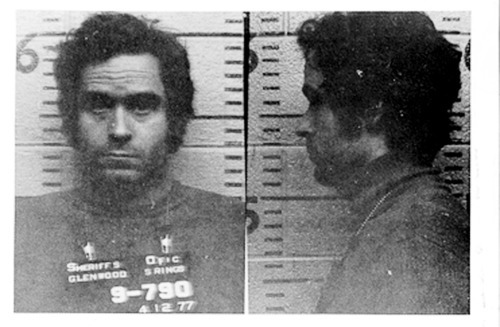
June 7, 1977, Ted was transported from the Garfield County jail in Glenwood Springs to Pitkin County Courthouse in Aspen for a preliminary hearing. He waived his right to a court appointed attorney and opted to serve as his own, and as such, was excused by the judge from wearing handcuffs or leg shackles. During a recess of the trial, he asked to visit the courthouse's law library to research his case. While out of view from his guards, behind a bookcase, he opened a window and jumped to the ground from the second story. He managed to injure his right ankle in the process as he landed. He shed the outer layer of his clothing. He walked through Aspen as roadblocks were being set up on its outskirts after noticing his disappearance, then hiked southward onto Aspen Mountain. Near the summit of the mountain, he broke into a hunting cabin. He was able to steal food, clothing, and a rifle. The following day he left the cabin and continued south toward the town of Crested Butte. Although, during this time he had managed to get lost in the forest. For two days he wandered aimlessly in the mountain forest, missing the two trails that led downward to his intended destination. On June 10th, 1977, he broke into a camping trailer on Maroon Lake, taking food and a ski parka; instead of continuing southward, he walked back north toward Aspen, eluding the roadblocks and search parties along the way. Three days later, he stole a car at the edge of an Aspen Golf Course. He drove back into Aspen, where two police officers noticed his car weaving in and out of its lane and pulled him over. He had been a fugitive for six days.
Back in jail at Glenwood Springs, Ted again ignored legal advice to stay put (not to try to escape again). It was said that the case against him, already weak at best, was deteriorating steadily as pre-trial motions consistently resolved in his favor and significant bits of evidence were ruled inadmissible. A quote stating, "A more rational defendant might have realized that he stood a good chance of acquittal, and that beating the murder charge in Colorado would probably have dissuaded other prosecutors... with as little as a year and a half to serve on the DaRonch conviction, had Ted persevered, he could have been a free man.” had shown that. But instead, Ted assembled a new escape plan. He acquired a detailed floor plan of the jail and a hacksaw blade from other inmates, and collected $500 in cash. This was smuggled in over a six-month period, by visitors, Mostly Carol Boone. During the evenings, while other prisoners were showering, he sawed a hole about one square foot, between the steel reinforcing bars in his cell's ceiling and, having lost 35 pounds, he was able to wriggle through it into the crawl space above. In the weeks that followed, he made several “practice runs”, exploring the space. Multiple reports from an informant of movement within the ceiling during the night were not investigated. By late 1977, Bundy's impending trial had become very high flying in the media in the small town of Aspen. Ted then filed a motion for a change of venue to Denver. On December 23rd, 1977, the Aspen trial judge granted the request, but he was sent to Colorado Springs, where juries had historically been hostile to murder suspects. On the night of December 30, with most of the jail staff on Christmas break and nonviolent prisoners on furlough with their families. Bundy piled books and files in his bed, covered them with a blanket to simulate his sleeping body, and climbed into the crawl space. He broke through the ceiling into the apartment of the chief jailer, who had been out for the evening with his wife. He changed into street clothes from the jailer's closet, and literally walked out the front door to his freedom.
Florida Murders and Assaults

Ted arrived in Tallahassee, Florida on January 8th, 1978, and rented a room under the alias of Chris Hagen at the Holiday Inn. Here Bundy tried to find work and leave his criminal past behind, thinking he’d be able to remain free if he didn’t bring police suspicion onto himself. He then was forced to leave his only job application after being asked to provide identification. He reverted to shoplifting and stealing credit cards from women’s wallets out of shopping carts. On January 15th, 1978, he entered Florida State University’s sorority Chi Omega. Starting at 2:45am, he bludgeoned Margaret Bowman and then garoted her with a nylon stocking. He moved on to Lisa Levy’s bedroom, who was beaten unconscious, strangled her, tore one of her nipples, bit deeply into her left buttock, and sexuallly assaulted her with a hair mist bottle. In the bedroom adjoining Lisa's, he attacked Kathy Kliener. He had broken her jaw and had a deep laceration on her shoulder. Karen Chandler was also attacked in her bedroom, she suffered a concussion, loss of teeth, a broken jaw, and a crushed finger. Kathy and Karen both survived and attributed their survival to the attacker being scared off by headlights illuminating through the window. The whole attack happened within fifteen minutes with thirty witnesses in earshot who seemingly heard nothing. Shortly after leaving the sorority, Ted broke into the basement apartment of Cheryl Thomas, eight blocks away. He dislocated her shoulder and fractured her jaw and skull in five different places during this attack.
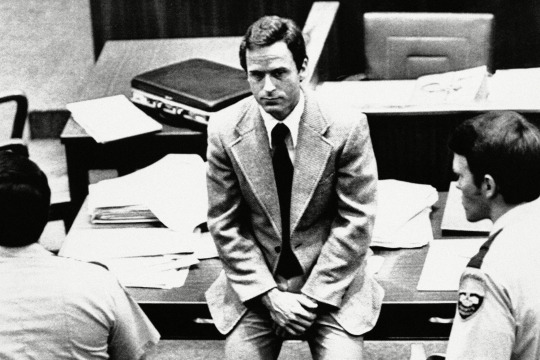
On February 8th, 1978, he approached the daughter of Jacksonville chief of Police, 12-year-old Leslie Parmenter, introducing himself as “Richard Burton, fire department”. He only backed off when challenged by Leslie’s older brother who had shown up to pick her up. That day, he backtracked to Lake City. February 9th, 1978, at Lake City Junior High, 12-year-old Kimberly Dianne Leach was summoned to retrieve a forgotten purse in her homeroom class and was never seen afterwards. Her mummified remains were found seven weeks afterwards in a pig farrowing shed near Suwannee River State Park. It appears she had been raped (her underwear was found near the body with semen in them) and her throat had been slit. On February 12th, 1978, Bundy could not pay his rent and had the growing suspicion that police were closing in on him, he decided to flee Tallahassee. Three days later he was apprehended by Pensacola officer, David Lee, near the Alabama border. In Miami, June of 1979, Ted stood trial for the Chi Omega killings and assaults. The jury deliberated for less than seven hours before convicting him on July 24, 1979, of the Bowman and Levy murders, three counts of attempted first degree murder and two counts of burglary. In January 1980, six months after his first Florida convictions, Ted stood trial in Orlando for the kidnapping of Kimberly Dianne Leach. After less than eight hours of deliberation, Ted was found guilty again. During the penalty phase of his trial, Bundy took advantage of an obscure Florida law; providing that a marriage declaration in court, in the presence of a judge, constituted a legal marriage. As he was questioning former Washington State DES coworker Carole Ann Boone, who had moved to Florida to be near Bundy, had testified on his behalf during both of his trials, and was again testifying on his behalf as a character witness, asked her to marry him. She accepted, and Bundy declared to the court that they were legally married. February 10th, 1980, Ted’s was sentenced to death by electrocution for the third time. In October of 1981, Carol Anne Boone, gave birth to a daughter and named Ted Bundy as the father.

Ted Bundy died by the Raiford electric chair at 7:16 a.m. EST on January 24, 1989. Hundreds of revelers sang, danced and set off fireworks in a pasture across from the prison as the execution was carried out, then cheered as the white hearse containing Bundy's corpse departed the prison. He was cremated in Gainesville, Florida and his ashes scattered at an undisclosed location in the Cascade Range of Washington State, in accordance with his will.
20 notes
·
View notes
Text
Ted Bundy
Ted Bundy
Theodore Robert Bundy (born Theodore Robert Cowell, 24 November 1946–24 January 1989) was an American serial killer who abducted, raped, and killed several young women and girls in the 1970s and possibly earlier. Until his execution in 1989, after more than a decade of denials, Ted Bundy admitted to 30 murders that he committed between 1974 and 1978 in seven states.
Arrest and the first trial
On 16 August 1975, Bundy was arrested in Granger (another suburb of Salt Lake City) by Utah Highway Patrol officer Bob Hayward Hayward had observed Bundy cruising a residential area in the early morning hours; Bundy fled the area at high speed after seeing the patrol car.
The officer searched the car after he found that the Volkswagen front passenger seat had been removed and placed on the front passenger seat. He found a ski mask, a second pantyhose-fashioned mask, a crowbar, handcuffs, trash bags, a rope chain, an ice pick, and other things that were originally supposed to be burglary devices. Bundy explained that the ski mask was for skiing, found the handcuffs in a dumpster, and the rest were common household items. Detective Jerry Thompson, however, recalled a similar suspect and description of the vehicle.
Victims
How many people did Ted Bundy kill? We may never know the full extent of Bundy's heinous crimes, but we can share the tales of the women who we know crossed his path.
Ted Bundy’s Victims in Washington and Oregon
The violent killings of Ted Bundy are thought to have started in Seattle, Washington. He committed his first "official" killings after earning his bachelor's degree from Washington University in 1972
Karen Sparks
It is widely believed that the first of the victims of Bundy is 18-year-old Karen Sparks. Also known in Bundy literature as Joni Lenz, on January 4, 1974, the UW student was attacked in her sleep.
Lynda Ann Healy in 1969
Lynda Ann Healey, 21, was the next victim of Bundy. Healey was a famous student at UW and at a local radio station gave weather and ski updates. Her friends became extremely suspicious of her death.
Police found blood on the bed sheets and pillows of Healey, but not enough to suggest she had bled to death, and no hint of where she might have gone.
Three days after her kidnapping, a male voice called 911 according to Ann Rule's The Stranger beside Me: "Listen. And listen attentively. The person who attacked that girl on the eighth of last month and the person who took Lynda Healey away are one and the same. He was outside both houses. He was seen. ”Police never got the caller's name.
Death
Ted Bundy died at 7:16 a.m. in the Raiford electric chair. He was 42 years old on January 24, 1989. Hundreds of reveler including 20 off-duty police officers on one account sang, danced, and set off fireworks in a field across the street from the prison as the execution took place, then loudly cheered as the white hearse carrying his corpse left the prison].
1 note
·
View note
Text

WARNING: GRAPHIC CONTENT
Theodore Robert Bundy was born to a twenty two year old woman named Eleanor Cowell on November 24, 1946 in Burlington, Vermont. Eleanor Cowell was the daughter of two very religious parents and being unmarried at the time of her pregnancy and birth, she was sent to have the child in at a home for unwed mothers. Shortly after the birth of her son Theodore she and her baby returned to her parent’s home in Philadelphia, where they would hide the illegitimate birth by claiming he was Eleanor’s adopted brother. A few years later, Cowell took her son and moved to Tacoma, Washington where she married a man named Johnnie Bundy. The family created a content home.
At an early age, Theodore, or as we know him today, Ted or Teddy Bundy, began showing some very unsettling interests in darkness. At age three he became fascinated with knives and later in his school aged years and teens he would peer into windows of young women and steal things that he wanted without a second thought leading to a comprehensive juvenile record. When he turned eighteen the record was dropped. When discussing his childhood and teenaged years, Bundy recollected being very introverted.
He first attended the University of Puget Sound and then transferred to the University of Washington in 1966. There, Theodore fell in love with a woman of wealth and status and they dated for a short period of time. Her most common pseudo-name was Stephanie Brooks, although she gave many to protect her identity. He was desolate over their breakup to which she claimed was in response to Theodore’s lack of ambition and immaturity after dropping out of college in 1968 and working a series of minimum wage jobs. He ran off to Colorado after his breakup with ‘Stephanie’ and ended up visiting family members in Arkansas and Philadelphia. In the spring of 1969 he attended one semester at Temple University but in fall of the same year went back to enroll in the University of Washington. He then met Elizabeth Kloepfer. A divorcée from Utah whom he dated for several years.
In 1972 he graduated with a degree in psychology. In the mid 1970s Bundy had worked his way into a higher social and political status in Washington, volunteering a second time in political campaigns and was awarded with letters of high recommendation for the law program. In 1973 during a trip to California, Bundy rekindled his relationship with ‘Stephanie Brooks’ and even went as far to introduce her to one of his psychology professors as his fiancée. In January of 1974 he unexpectedly ceased all contact with ‘Brooks’. He said in interviews that he essentially just wanted to prove that he was good enough to marry her.
Bundy confessed to attempting his first abduction in 1969 in New Jersey but claimed he hadn’t murdered anyone in Seattle. He also implicated but never fully disclosed earlier murders in 1971, 1972 and 1973. It is unclear where and when he began murdering young women. He was very elusive and told many different versions of his stories to different people.
Therefore, Ted Bundy’s earliest known victim was murdered in 1974. Around this time several young women had disappeared in the Seattle and nearby Oregon areas.
On January 4, 1974 Ted Bundy beat eighteen year old Karen Sparks until she was unconscious and then sexually assaulted her body with the rod he used to murder her. She managed to survive but sustained mental and physical disabilities from the attack.
In February of the same year, he broke into the home of Lynda Ann Healy, rendered her unconscious, and abducted her. March 12, 1974 nineteen year old Donna Gail Manson. April 17 Susan Elaine Rancourt disappeared on her way to her dormitory. May 6 Roberta Kathleen Parks never made her coffee date with friends. At this point, at least one woman per month was disappearing. On June 11 twenty-two year old Georgann Hawkins disappeared on her way to her boyfriend’s dorm.
During all of these disappearances, Bundy was working at the Olympia Department of Emergency Services, involved in the investigation of these missing women. While working there, he met and dated Carole Ann Boone, a woman who was twice divorced and a mother of two.
As women continued disappearing across the Pacific Northwest reports came in of a man wearing a sling and driving a tan or brown Volkswagen Beetle. In July, two women went missing from a crowded beach in broad daylight. Janice Anne Ott aged twenty three and nineteen year old Denise Marie Naslund both disappeared and reports of a man with the same previous description, a sling and a tan beetle, who had given a loaded story about needing help unloading his sailboat. There was no sailboat. He lured the two women to their deaths.
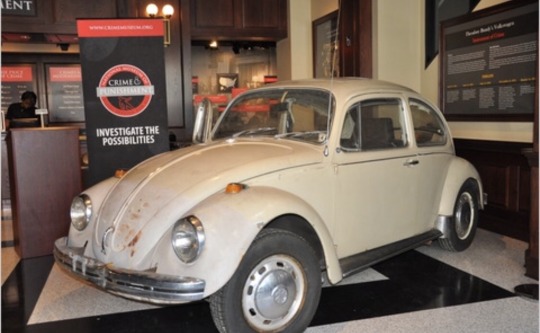
After a sketch and description was released to the public, three of Bundy’s former acquaintances recognized the sketch to look like Theodore. The police however disagreed to him being a possible suspect because he was a clean cut law student with a lack of an adult criminal record.
In August, Bundy discovered that he was not quite as cut out for law school as he’d originally thought. He found the courses he took to be much more difficult and was greatly disappointed that he could not comprehend his lessons. Following this disappointment, a new string of murders began.
In September of 1974, hunters stumbled across human remains. Six months later, forestry students uncovered more human remains that had been dumped. They discovered skulls, vertebrae, and other skeletal remains. As more women continued to disappear, Bundy’s occasional girlfriend Elizabeth called the police to repeat her suspicions about Theodore and he was officially added to the list of suspects.
On August 16, 1975 Ted Bundy was arrested in Utah. His tan Volkswagen Beetle contained a ski mask, a crowbar, handcuffs, an ice pick, and other items generally used for breaking and entering and burglary. Along with the tools that Bundy describes as regular household items (excluding the ski mask he explained to be used for skiing and the handcuffs he had claimed he found in a dumpster) the police also found a brochure to Colorado ski resorts and a brochure for a high school play where one of the victims had disappeared in a search of his house. But it was only circumstantial evidence at best and Bundy was released. He was arrested again and in June of 1976 he was sentenced to one to fifteen years in prison. From there Bundy would escape and flee to several different states including Michigan, Georgia, and eventually, Tallahassee, Florida where he stayed in a boarding house under the alias Chris Hagen.
He claimed that he planned to move forward with his life, working and committing less criminal acts, but it didn’t take long for him to begin shoplifting and theft, he also stole credit cards from women’s purses. One week after his arrival in Florida, in January of 1978, he entered a sorority house of Florida State University and attacked four women, beating them, destroying their bodies, and sexually assaulting them. In the same night, he broke into the apartment of another young woman named Cheryl Thomas. He raped and beat her leaving her with permanent deafness and equilibrium issues. At the crime scene the police found semen and a pantyhose ‘mask’ and two hairs.
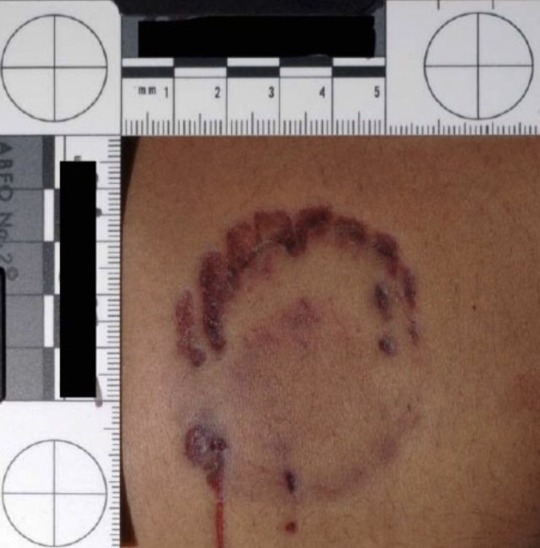
In February of 1978 Bundy attempted to abduct a young girl in Jacksonville until the girl’s older brother showed up. Bundy retreated and fled to Lake City where he murdered twelve year old Kimberly Diane Leach. A few days later he made his way back to Tallahassee with a stolen car. He was stopped by a Pensacola officer (one of my two home towns, eerily awesome) and after a vigorous chase and an added charge of assault to a police officer, Bundy was subdued and arrested. In 1979 and 1980 Ted R. Bundy was sentenced three times to death by electrocution. Upon his sentence he shouted, “Tell the jury that they were wrong!”
During his confessions while on death row, Ted Bundy stated that he considered himself to be amateur and impulsive as a murderer until he reached his prime phase beginning in 1974, insinuating that he had begun killing before his first official identified victim, but he never explicitly confessed to murdering anyone before that time.
In 1986 Bundy confessed to returning to the scenes where he had dumped previous victims, multiple times. He said that he would lie with them and perform sexual acts with their putrefying corpses and would continue to do so until their bodies were too decomposed to continue. He confessed to many other horrific crimes including decapitation, lewd acts with a corpse, sexual assault, murder, and mutilation.
Bundy confessed to the murder of at least thirty six young women. On January 24, 1989 about 7:00 AM at the age of forty two, Theodore Robert Bundy died at Florida State Prison by electrocution. He was pronounced dead at 7:16 AM. His body was cremated and before his death he requested that his ashes be scattered in the Cascade Mountains of Washington where at least four of his victims had been disposed. It is unclear from my research what they actually did with his remains. If you know, comment below!
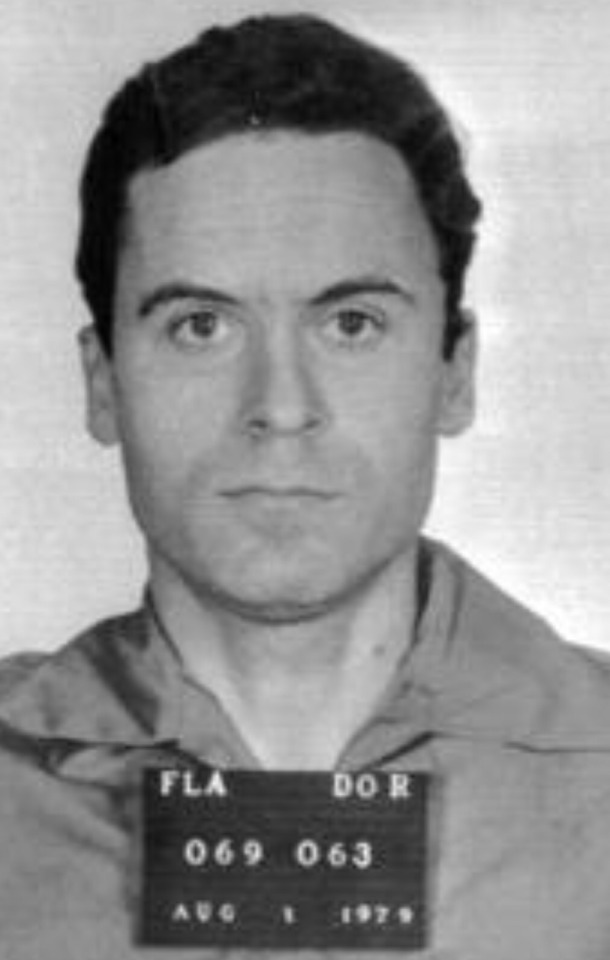
In a final interview, Bundy told reporters that he “deserved the most extreme punishment [that] society has.” He spent his final days praying with a Methodist priest and he even cried. According to the priest he didn’t want to die.
He told reporters in his final interview that he was a normal person and a helpless kind of victim and not some bum or loser hanging out at a bar. He claimed that he felt remorse for all of his sexually motivated killings and even added in that , “killing me isn’t going to restore those beautiful children to their parents.”
His last words: “Yes, Jim and Fred” (his minister and his lawyer) “I’d like you to give my love to my family and friends.”
Ted Bundy was a wreckless and careless murderer. He didn’t bother to cover his tracks and he didn’t care about being seen by others. He hid in plain sight and even though he claims he was not impulsive and amateur after 1974 in reality he always was.
Post Mortem:
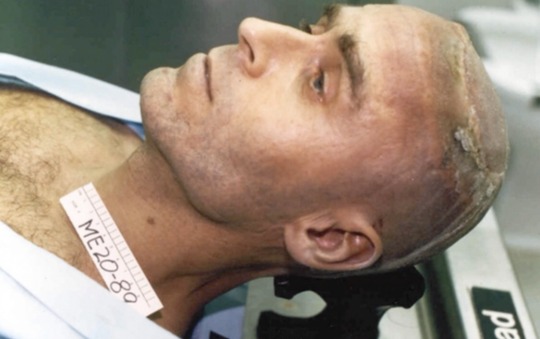
3 notes
·
View notes
Text
16/05/2020
Today i’m focusing on finishing off my my final major project and what i need to do to get this complete is add in one final wall to my exhibition and here is all of the information that is required to do so.
Ted Bundy was born in Vermont, across the country from the Pacific Northwest communities he would one day terrorize. His mother was Eleanor Louise Cowell and his father was unknown. His grandparents, ashamed of their daughter’s out-of-wedlock pregnancy, raised him as their own child. For nearly all of his childhood, he believed his mother to be his sister.

His grandfather would regularly beat both Ted and his mother, causing her to run away with her son to live with cousins in Tacoma, Washington, when Bundy was five years old. There, Eleanor met and married hospital cook Johnnie Bundy, who formally adopted the young Ted Bundy and gave him his last name.
Bundy disliked his step-father and would later describe him to a girlfriend disparagingly, saying he wasn’t very bright and didn’t make much money.
Little else is known for sure about the remainder of Bundy’s childhood, as he gave conflicting accounts of his early years to different biographers. In general, he described an ordinary life punctuated by dark fantasies that affected him powerfully — though the degree to which he acted on them remains unclear. The reports of others are similarly confused. Though Bundy described himself as a loner who would stalk the seedy streets at night to spy on women, many who remember Bundy from high school describe him as reasonably well-known and well-liked.
College Years And His First Attack
Ted Bundy graduated from high school in 1965, then enrolled in the nearby University of Puget Sound. He spent just one year there before transferring to the University of Washington to study Chinese.
He dropped out briefly in 1968 but quickly re-enrolled as a psychology major. During his time out of school, he visited the East Coast, where he likely first learned that the woman he believed to be his sister was actually his mother.
Then, back at UW, Bundy started dating Elizabeth Kloepfer, a divorcée from Utah who worked as a secretary at the School of Medicine on campus. Later, Kloepfer was among the first to report Bundy to police as a suspect in the Pacific Northwest murders.
Also among the four people who gave police Bundy’s name was former Seattle police officer Ann Rule, who met Bundy at around this same time while they were both working at Seattle’s suicide hotline crisis center.
Rule would later write one of the definitive biographies of Ted Bundy, The Stranger Beside Me.

Ann Rule remembers the moment she realized Bundy was a killer.
In 1973, Bundy was accepted into the University of Puget Sound Law School, but after a few months, he stopped attending classes.
Then, in January of 1974, the disappearances began.
Ted Bundy’s first known attack was not an actual murder, but instead an assault on 18-year-old Karen Sparks, a student and dancer at the University of Washington.
Ted Bundy’s First Murders Across Seattle
Ted Bundy’s next victim and his first confirmed murder was Lynda Ann Healy, another UW student.
A month after his assault on Karen Sparks, Bundy broke into Healy’s apartment in the early morning, knocked her unconscious, then clothed her body and carried her out to his car. She was never seen again, but part of her skull was discovered years later at one of the locations where Bundy dumped his bodies.
Afterward, Bundy continued targeting female students in the area. He developed a technique: approaching women while wearing a cast or appearing otherwise disabled and asking them to help him put something in his car.
He would then bludgeon them unconscious before binding, raping, and killing them, dumping their bodies in a remote location in the woods. Bundy would often revisit these sites to have sex with their decaying corpses. In some cases, Bundy would decapitate his victims and keep their skulls in his apartment, sleeping beside his trophies.
A woman who survived Ted Bundy’s attack in the 1970s reveals what saved her: her hair.
“The ultimate possession was, in fact, the taking of the life,” Bundy once said. “And then . . . the physical possession of the remains.”
“Murder is not just a crime of lust or violence,” he explained. “It becomes possession. They are part of you . . . [the victim] becomes a part of you, and you [two] are forever one . . . and the grounds where you kill them or leave them become sacred to you, and you will always be drawn back to them.”
Over the next five months, Bundy abducted and murdered five female college students in the Pacific Northwest: Donna Gail Manson, Susan Elaine Rancourt, Roberta Kathleen Parks, Brenda Carol Ball, and Georgann Hawkins.
Responding to this rash of disappearances, police called for a major investigation and enlisted a number of different government agencies to help look for the missing girls.
One of these agencies was the Washington State Department of Emergency Services, where Bundy worked. There, Bundy met Carole Ann Boone, a twice-divorced mother of two whom he would date on and off for years as the murders continued.
Relocation To Utah And Arrest For Kidnapping
As the manhunt for the abductor continued, more witnesses produced descriptions that matched Ted Bundy and his car. Just as some of his victims’ bodies were being discovered in the woods, Bundy was accepted to law school in Utah and moved to Salt Lake City.
While living there, he continued to rape and murder young women, including a hitchhiker in Idaho and four teenage girls in Utah.
Kloepfer was aware that Bundy had relocated to the area, and on learning of the Utah murders, she called the police a second time to reaffirm her suspicion that Bundy was behind the killings.
There was now a mounting pile of evidence pointing toward Ted Bundy, and when Washington investigators compiled their data, Bundy’s name appeared at the top of the suspect list.
Unaware of law enforcement’s growing interest in him, Bundy continued killing, journeying to Colorado from his home in Utah to murder more young women there.

Finally, in August 1975, Bundy was pulled over while driving through a Salt Lake City suburb, and police discovered masks, handcuffs, and blunt objects in the car. While this was not enough to arrest him, a police officer, realizing that Bundy was also a suspect in the earlier killings, put him under surveillance.
The officers then found his Beetle, which he had since sold, where they discovered hair matching three of his victims. With this evidence, they put him in a lineup, where he was identified by one of the women whom he had attempted to abduct.
He was convicted of kidnapping and assault and sent to prison while police attempted to build a murder case against him.
Ted Bundy Escapes Jail In Aspen
But arrest didn’t stop Bundy from killing.
He was soon able to, for the first of two times in his life, escape from custody.
In 1977, he escaped from the law library at the courthouse in Aspen, Colorado.
Because he was serving as his own lawyer, he had been allowed into the library during a break in his preliminary hearing. Nominally, he was researching the laws pertaining to his case. But the fact that he was his own counsel also meant he was unshackled — and when he saw his chance, he took it.
He jumped from the library’s second-floor window and hit the ground running, disappearing into the trees before the guard returned to check on him.
He planned to make his way toward Aspen Mountain, and he broke into a cabin and later a trailer for supplies. But resources were scarce, and it wasn’t long before he scrapped his plan to vanish into the wilderness.
Back in Aspen, he stole a car, thinking to put some distance between himself and the jail cell he was fleeing.
But the reckless speed with which he left Aspen made him conspicuous, and police officers spotted him. He was recaptured after six days of being on the run.
The Chi Omega Murders At Florida State
Bundy’s next escape took place just six months later, this time from a jail cell.
After carefully studying a map of the prison, Bundy realized that his cell was directly beneath the living quarters of the prison’s chief jailer; the two rooms were separated only by a crawl space.
Bundy traded with another inmate to get a small hacksaw, and while his cellmates were exercising or showering, he worked away at the ceiling, scraping away layer after layer of plaster.
The crawl space he made was small — very small. He began deliberately cutting back on meals in an effort to lose weight.
He also planned ahead. Unlike last time, when his escape had failed because he was without resources in the outside world, he stowed away a small pile of money smuggled to him by Carole Ann Boone, the woman who would later marry him in prison.
When he was ready, Bundy finished the hole and crawled up into the chief jailer’s room. Finding it unoccupied, he swapped his prison jumpsuit for the man’s civilian clothes and strolled out the jail’s front doors.
This time, he didn’t dawdle; he stole a car immediately and got out of town, making his way to Florida.
It had been Bundy’s intention to keep a low profile, but Florida life was presenting unexpected challenges. Unable to produce identification, he couldn’t get a job; he was back to grifting and stealing for money. And the compulsion toward violence was simply too strong.
On January 15, 1978, two weeks after his escape, Bundy broke into a Chi Omega sorority house on the Florida State University campus.
Within the span of just 15 minutes, he sexually assaulted and killed Margaret Bowman and Lisa Levy, bludgeoning them with firewood and strangling them with stockings. He then assaulted Kathy Kleiner and Karen Chandler, who both suffered horrific injuries, including broken jaws and missing teeth.
He then broke into the apartment of Cheryl Thomas, who lived several blocks away, and beat her so badly she lost her hearing permanently.
Still on the run on February 8, Bundy abducted 12-year-old Kimberly Diane Leach from her middle school and murdered her, concealing her body on a pig farm.
And then, once again, his reckless driving caught the attention of the police. When they realized that his plates belonged on a stolen car, they pulled him over and found the IDs of three dead women in his vehicle, linking him to the FSU crimes.
“I wish you had killed me,” Bundy told the arresting officer.
Trial And Execution
Throughout his ensuing trial, Bundy sabotaged himself by ignoring the advice of his lawyers and taking charge of his own defense. He unnerved even those assigned to work with him.
“I would describe him being as close to being like the devil as anyone I ever met,” said defense investigator Joseph Aloi.
Bundy was ultimately convicted and placed on death row at Florida’s Raiford Prison, where he suffered abuse from other prisoners (including a gang rape by four men, some sources say) and conceived a child with Carole Ann Boone, whom he’d married while he was on trial.
With hours left to live, Ted Bundy reflects on his crimes.
Bundy was finally executed by electric chair on January 24, 1989. Hundreds of people gathered outside the courthouse to celebrate his death.
“For everything he did to the girls — the bludgeoning, the strangulation, humiliating their bodies, torturing them — I feel that the electric chair is too good for him,” said Eleanor Rose, the mother of victim Denise Naslund.
Bettmann/Getty ImagesFSU’s Chi Phi fraternity celebrates the execution of Ted Bundy with a large banner that says “Watch Ted Fry, See Ted Die!” as they prepare for an evening cookout where they will serve “Bundy burgers” and “electrified hot dogs.” 1989.
Though he confessed to many murders before his death, the true number of Bundy’s victims remains unknown. Bundy denied certain killings, despite physical evidence tying him to the crimes, and alluded to others that were never substantiated.
Ultimately, all of this has led authorities to suspect Bundy killed anywhere from 30 to 40 women, making him one of the most infamous and terrifying serial killers in American history — and perhaps “the very definition of heartless evil.”
0 notes
Text
Ted Bundy, un asesino carismático
Nombre y fecha de nacimiento
Theodore Robert Cowell, más conocido como Ted Bundy, nació el 24 de Noviembre de 1946.

Sus víctimas
Durante los años 1974 y 1975 violentó y asesinó a más de 30 mujeres. Entre sus víctimas se encuentran: Joni Lenz, Lynda Ann Healy, Carol Valenzuela, Nancy Wilcox, Donna Masson, Susan Rancourt, Roberta Parks, Brenda Ball, Georgann Hawkins, Janice Otto, Melissa Smith, Denise Naslund, Laura Aimee, Carol DaRonch, Debbie Kent, Caryn Campbell, Denise Oliverson, Melanie Cooley y Shelley Robertson. Se cree que hubo más afectadas, sin embargo, sus cuerpos no han sido encontrados.
Modus Operandi
Ted Bundy siempre elegía víctimas similiares: jóvenes, estudiantes universitarias, blancas y de cabello negro. Él era consciente de su carisma y de su facilidad de manipular a las mujeres, por tanto, comenzó a buscar a sus víctimas simulando tener un brazo roto o que necesitaba ayuda con su auto. Acostumbraba a violar y descuartizar los cuerpos, para luego usar algunas partes de los mismos como “trofeos”.
Perfil psicológico
A pesar de la idealización que daba de su infancia, donde afirmaba no haber tenido ningún tipo de conflicto, se confirmó que Bundy tuvo una infancia problemática. En sus primeros años tenía una afición por matar animales, además, a sus 14 años descubrió ser el hijo de quien decía ser su hermana mayor, y que no se conocía a su padre biológico. Años más tarde, Stephanie Brooks, su novia durante la universidad, le terminó luego de dos años de relación. Este rechazo, más lo vivido en su infancia, generó que Bundy se convirtiera en un asesino bastante narcisista y manipulador.
Muerte
Luego de ser capturado y atravesar por varios juicios, Ted Bundy fue condenado a la silla eléctrica y murió electrocutado en la Prisión Estatal de Florida en el año 1989.
Series y películas
Debido a sus atroces asesinatos, Ted Bundy sigue siendo un tema del que hablar hoy en día, en consecuencia, se le continúa representando en varias series y películas.
1. Deliberadamente extraño (1986).

2. Ted Bundy (2002).

3. Un extraño a mi lado (2003).

5. Bundy: Un legado del mal (2008).

6. Conversaciones con asesinos: las cintas de Ted Bundy (2019).

7. Extremadamente cruel, malvado y perverso (2019).

Fuentes
https://spoilertime.com, https://psicologia.laguia2000.com y la serie de Netflix “Conversaciones con asesinos: las cintas de Ted Bundy”.
0 notes
Link
In the category of TELEVISION: Anthony Anderson, Gillian Anderson, Lynda Carter, Simon Cowell, RuPaul Charles, Taraji P. Henson, Eric McCormack, Ryan Murphy, Niecy Nash, Mandy Patinkin, Shonda Rhimes and posthumously: Steve Irwin
#gillian anderson#hollywood walk of fame#hollywood walk of fame 2018#she is getting her own star YAY#where is it going to be?
21 notes
·
View notes
Text
De Harry Potter en casa al Servicio Nacional de Estantería: Diversión en los libros para bloquear | Libros
gEl artista Ruffalo Axel Scheffler publicó un nuevo libro ilustrado gratuito que explica el coronavirus a los niños, Marian Keyes invitó a los lectores a sentarse con ella para una taza de té virtual, y Cressida Cowell lee Cómo entrenar a tu dragón en voz alta para niños confinados. Debido a que la industria del libro hace todo lo posible para ayudar a entretener a las masas encerradas de Inglaterra, sean bibliotecarios expertos, ahora incapaces de trabajar en sus sucursales, ofreciendo consejos de lectura, JK Rowling presentando a Harry Potter en casa o Kit de Waal reuniendo un Big Book Weekend que reúne lo mejor de los festivales de libros británicos cancelados debido a un coronavirus.
Estas son algunas de las mejores actividades gratuitas disponibles para los amantes de los libros, que continuaremos actualizando durante el bloqueo:
Harry Potter en casa: "Trae Hogwarts para ti", el nuevo sitio web ofrece a los niños locos una mezcla de videos, rompecabezas y concursos. Dibujar un niffler, tejer una bufanda inspirada en Weasley y explorar tu casa de Hogwarts están en oferta.
BookTrust: Hay una gran cantidad de actividades en el sitio web de la organización benéfica. El ganador de los niños, Cowell, lee un capítulo al día de Cómo entrenar a tu dragón, ilustradores como Rob Biddulph nos muestran cómo dibujar a sus personajes, y Andy Stanton tiene consejos para escribir una historia divertida. También recolectaron amablemente la gran cantidad de actividades para niños.
Autor: El sitio web ofrece desafíos creativos diarios de 10 minutos a hijos de escritores como Abi Elphinstone, Anna James y Lucy Worsley.
En casa con pingüino: Los martes a las 5 p.m. BST, autores como Marian Keyes, Richard Osman y Caroline Criado-Perez transmitieron en vivo desde su casa, donde revelan cómo manejan la vida en el interior y qué ellos leen y miran para atravesar el parto.
Faber: En Twitter, el editor lanzó un programa en línea, que incluye al galardonado poeta Simon Armitage leyendo y reflexionando sobre sus poemas de Marsden todos los lunes, viernes por la tarde, lecturas de libros ilustrados y noticias mediodía de escritores como Sebastian Barry y Edna O & # 39; Brien.
Servicio nacional de estantería: Los bibliotecarios británicos lanzaron una transmisión diaria en vivo de YouTube a las 11 a.m. [hora de París] con recomendaciones de libros para niños y familias, en un momento en que algunos servicios de la biblioteca informan un aumento en los préstamos de libros en línea. hasta 700% Emily Haire, una bibliotecaria de la escuela de Belfast, fue la primera en embarcarse en la novela juvenil de Lisa Williamson, Carnegie, Paper Avalanche, sobre una adolescente cuya madre es un montón.
Libro de imágenes gratuito de Axel Scheffler: El ilustrador de Gruffalo presenta el coronavirus y las medidas tomadas para controlarlo de manera comprensible para los niños. "Me preguntaba qué podría hacer como ilustrador infantil para informar y entretener a mis lectores aquí y en el extranjero", dijo Scheffler. "Creo que es extremadamente importante que los niños y las familias tengan acceso a información buena y confiable en esta crisis sin precedentes, y espero que la popularidad de los libros que tengo Hecho con Julia Donaldson garantizará que este libro digital llegue a muchos niños que ahora son un poco mayores, pero que aún pueden recordar nuestros libros ilustrados. "
El gran fin de semana del libro: Cofundado por los autores Kit de Waal y Molly Flatt, este festival virtual tendrá lugar del 8 al 10 de mayo y contará con la participación de grandes nombres como Robert Webb y Maggie O & # 39; Farrell, así como los primeros autores que podría sentir que perdieron su momento al sol mientras se bloquean. Con los festivales de libros desde Hay en Edimburgo hasta Harrogate ahora en el hielo, albergará eventos "patrocinados" por el festival en cuestión, con autores y otros artistas que pueden haber aparecido.
Festival Literario del Heno: Con el festival de este año en mayo ahora pospuesto, Hay está planeando la "primera versión totalmente digital" con seminarios web, talleres y preguntas y respuestas en vivo en las redes sociales programadas para todo el mes de mayo. También ha lanzado un podcast Hay Festival, que brinda acceso gratuito a eventos pasados, incluido Stephen Fry con el autor de East West Street, Philippe Sands. Los invitados que vienen incluyen a Chimamanda Ngozi Adichie, Hilary Mantel, Naomi Klein y Caitlin Moran.
La serie de aislamiento de Aitken Alexander: Los escritores de la agencia literaria, incluidos Mark Haddon y Diana Evans, respondieron creativamente al encierro con ensayos y ficciones cortas, que pueden leerse en línea de forma gratuita.
Puffin Storytime: El editor infantil Puffin ofrece lecturas regulares y extractos de su lista de autores los lunes y viernes a las 3:30 p.m. BST. También lanzó un podcast de Puffin con el comediante y autor de niños Humza Arshad el 19 de abril, lleno de "cuentos de risa, juegos y chistes garantizados para hacerte reír".
The Bookshop Band: El musical literario que anteriormente pertenecía al Emporio de libros de Mr B en Bath tocará en vivo el viernes 10 de abril a las 8:30 p. M. BST, con canciones "inspiradas en cinco libros que nos encantan que puedes disfrutar durante el cierre". La presentación se transmitirá en varias páginas de Facebook. Vea la lista aquí.
Preguntas y respuestas de Lynda La Plante: Con gin-tonic en mano, el legendario perpetrador del crimen responderá las preguntas de los lectores todos los jueves a las 6 p.m.en su página de Facebook, y leerá extractos de su nuevo libro, Buried.
The post De Harry Potter en casa al Servicio Nacional de Estantería: Diversión en los libros para bloquear | Libros appeared first on Libro Mundo.
from WordPress http://libromundo.es/2020/04/09/de-harry-potter-en-casa-al-servicio-nacional-de-estanteria-diversion-en-los-libros-para-bloquear-libros/
0 notes
Text
Universal Credit 'Ditches Fast-Track Claims For The Terminally Ill'
Universal Credit ‘Ditches Fast-Track Claims For The Terminally Ill’
Families In Need Of Cannabis Oil Say Doctors Still Associate It With ‘Street Skunk’ Six Puppies Stolen In Armed Manchester Raid Have Died Facebook Removes Iran-Linked Accounts Targeting May And Corbyn Doctor Defends ‘Acid-Proof’ Make-Up Amid Animal Testing Fears Politics The Waugh Zone Theresa May Jeremy Corbyn Tories Brexit Labour Chancellor To Announce £1.5bn Support Package In Budget For Crisis-Hit High Streets As A Passionate Student Socialist, I Cannot Stand By And Watch The Tories Ruin This Country – It’s Time For A People’s Vote Labour’s Student Wing Demands Referendum On Final Brexit Deal Britain’s #MeToo Scandal Reveals How The Law Is Failing Victims Of Abuse Entertainment Celebrity Celeb Galleries Film Music TV Drama Daytime TV Binge TV Entertainment Insider Strictly Bake Off’s Sophie Faldo Accuses Explorer Anthony Middleton Of Mansplaining In Row About Women Serving In SAS Olly Murs Suggests He Might Not Be ‘On Talking Terms’ With Simon Cowell Over ‘X Factor’ Snub ‘Fantastic Beasts’ Star Claudia Kim Speaks Out After Backlash Over Her Casting Courtney Act’s ‘The Bi Life’ Hailed For Breaking Down Bisexual Stereotypes Lifestyle Health Mental Health Humankind Sourced Fitness Dating & Relationships Food Wellbeing Women Men Everybody Travel Home And Garden What To Do With Your Extra Hour When The Clocks Go Back ‘Fit Got Real’ Is The New Campaign Empowering Women To Exercise Their Way Sydney’s Same-Sex Penguin Couple Become Dads This Lipstick Shaped Vibrator Talks Back At You. Yes, You Heard That Right. Tech Reviews Gaming Space Apple Innovation Tech For Good Sustainability Ebay Takes Aim At Amazon With Lawsuit Accusing Them Of Illegally ‘Poaching Sellers’ YouTube Back Up And Running After Overnight Outage You Can Now Check How Much Money Political Groups Are Spending On Facebook Ads Forza Horizon 4 Review: A Racing Game For People Who Don’t Like Racing Games – HuffPost Verdict Parents Parents-To-Be New Parents Family Family Time Thriving Parents Parent Voices This Is Why You Should Give Kids Scary Stories To Read Scottish Tory Leader Ruth Davidson Gives Birth To Baby Boy Scottish Tory Leader Ruth Davidson Gives Birth To Baby Boy 6 Things Expectant Mothers Need To Know About Induced Labour Video MORE Comedy Style What’s Working Parent Voices Women Who Made Me Featured Digital Life Downtime Move For Health Backed By Let’s Talk About It NEWS 25/10/2018 22:36 BST | Updated 6 hours ago Universal Credit ‘Ditches Fast-Track Claims For The Terminally Ill’ System to speed up claims of those with just weeks to live “has been removed”, charity says. DWP denies claim. 1.7k By George Bowden Angela Raine Angela Raine, pictured beside her two children, received a terminal breast cancer diagnosis last year. Terminally ill people moved onto Universal Credit are continuing to suffer delays to first payments even when a doctor certifies they have just weeks to live, a leading charity has warned. Thousands of cancer patients are among those affected by the lapse, which could mean people die before receiving money to fund end of life care, Macmillan Cancer Support said. Under the older benefits system, such as Employment and Support Allowance, payments could be “fast-tracked” and paid at the highest rate if a doctor certified a person likely had less than six months to live. The apparent absence of a fast-track scheme on Universal Credit means those at the end of their lives – who are being transferred onto the new system, or are new claimants – now wait longer than ever for financial support, the cancer charity said. The issue was raised in a HuffPost UK report in December, in which one campaigner said: “We’ve seen people who are terminally ill dying before their Universal Credit is processed.” But the Department for Work and Pensions (DWP) strongly hit back at the fresh claims, saying: “It is simply not true that the fast track process for terminally ill claimants has been removed under Universal Credit.” Yet Macmillan, one of the UK’s leading cancer support charities, warned on Thursday that up to 26,000 people with cancer face a perilous five-week wait without any money when they transfer to the crisis-hit scheme. The in-built delay is applied to those who are already receiving benefits but who are transferred to Universal Credit as it continues a nationwide roll-out. It comes as pressure mounts on the government to plough billions back into the beleaguered welfare reform in Monday’s Budget. Grandmother Angela Raine quit her job last year after receiving the news she had incurable breast cancer. “Trying to apply for benefits has been a complete nightmare. I can’t explain quite how stressful it is,” the 55-year-old from Stanley, County Durham, said. “I want to cry just thinking about it.” “Navigating the system is a nightmare, that’s quite honestly the only way I can describe it,” she added. “The whole system is utterly inflexible and doesn’t take into account individual circumstances.” PA Viral News UK Cancer patients are at risk under Universal Credit, charity Macmillan has said. Macmillan’s chief executive, Lynda Thomas, called on the government to fix Universal Credit before it is rolled out to thousands more people in Angela’s position. She said: “People with cancer should be able to focus their energy on their health, not worrying about how to make ends meet when they are too unwell to work. “It is unacceptable to force patients to risk infection at Job Centres, log onto computers from hospital and wait more than a month for vital financial support, even at the end of their lives. “The system is failing people with cancer and we urge the Government to fix this benefit, before tens of thousands more vulnerable people are put at risk of hardship.” HuffPost reported last year how, unlike some of the benefits it replaces, Universal Credit does not have a dedicated team helping those nearing the end of their lives. Instead, terminally ill people were assigned “work coaches” and made to undergo meetings and visits at home. Universal Credit replaces six existing benefits into a single monthly payment and is gradually rolling out to all those who claim benefits across the country. The Department for Work and Pensions added in its full statement: “We’re determined to ensure that people living with terminal illnesses get the support they need through this difficult time and this continues to include fast tracking Universal Credit claims for claimants with a life expectancy of less than six months. “These claimants will also be awarded an additional amount of Universal Credit from the first day of their claim. “We have a visiting service for claimants with serious barriers. Claimants who are terminally ill and unable to make their claim for Universal Credit online, or attend a Jobcentre, are able to make their claim by telephone, or request a home or hospital visit. “At the visit, a DWP Visiting Officer will support the customer to make their claim for Universal Credit and verify the customer’s identity, enabling their claim to be progressed as quickly as possible. “Universal Credit (UC) replaces an out-of-date, complex benefits system. We brought in improvements which include increasing advances to 100%, removing the 7-day waiting period and paying people’s Housing Benefit for two weeks while they wait for the first UC payment, so no one needs to be without money during the first five weeks of a claim.” Do you have an experience relating to this story? Have we missed something out? Use this form , email [email protected] or WhatsApp +44 78968 04043 . SEE ALSO Revealed: Universal Credit Requires The Terminally Ill To Meet ‘Work Coaches’ What Is Universal Credit? At Our Foodbank, We Are Seeing The Flaws Of Universal Credit Suggest a correction George Bowden Reporter, HuffPost UK
Read More…
The post Universal Credit 'Ditches Fast-Track Claims For The Terminally Ill' appeared first on TBNT Have The Solution.
from TBNT Have The Solution https://ift.tt/2D9qnj8 via Article Source
0 notes
Photo

New Post has been published on https://shovelnews.com/weird-al-to-get-a-star-on-the-hollywood-walk-of-fame/
Weird Al to get a star on the Hollywood Walk of Fame
Weird Al Yankovic is famous for writing and singing parody songs about all things geeky.
Huston Huddleston
While everyone debates whether President Donald Trump should give up his ever-vandalized star or if the late, great Star Wars actor Carrie Fisher deserves a star of her own on the famous Hollywood’s Walk of Fame along along Hollywood Boulevard, it looks like comedy singer Weird Al Yankovic will be getting a star all to himself.
Yankovic, who performs under the name of Weird Al, is best known for his Grammy award-winning records. His songs often parody famous songs by pop stars including Michael Jackson and Pharrell as he sings about everything from parrot drones to taking selfies at funerals.
The Hollywood Chamber of Commerce, who are responsible for determining who gets a star on the Hollywood Walk of Fame, announced on Monday that Yankovic would be honored with a star dedicated in the category of Recording.
“Weird Al has single-handedly created an industry of parody! His fans have been waiting for this star for a very long time. We are excited to honor this very funny man on our world-famous Hollywood Walk of Fame,” Ana Martinez, Producer of the Walk of Fame ceremonies, said in a statement.
The time has finally come… On Aug. 27 at 11:30 AM I’ll be getting my very own star on the Hollywood Walk of Fame (6914 Hollywood Blvd., right across the street from the Chinese Theatre). The ceremony is FREE and open to the public, so come on down!!
— Al Yankovic (@alyankovic) August 13, 2018
Yankovic also tweeted about the honor on Monday: “The time has finally come… On Aug. 27 at 11:30 AM I’ll be getting my very own star on the Hollywood Walk of Fame (6914 Hollywood Blvd., right across the street from the Chinese Theatre). The ceremony is FREE and open to the public, so come on down!!”
Other celebrities who received a Walk of Fame star this year include Lin-Manuel Miranda, Lynda Carter, Taraji P. Henson, RuPaul, Snoop Dogg, Shonda Rhimes, Simon Cowell, Jennifer Lawrence and Zoe Saldana.
Source: https://www.cnet.com/news/weird-al-yankovic-to-get-a-star-on-the-hollywood-walk-of-fame/
0 notes
Text
Zoe Saldana Accepts NALIP Latino Media Award From Vin Diesel | Zoe Saldana
According to Page Six, Zoe Saldana, 39, will be handed the Outstanding Achievement in Film Award at the National Association of Latino Independent Producers' Latino Media Awards. Page Six reports that Jennifer Lawrence, Zoe Saldana, Taraji P. Henson, Lin-Manuel Miranda, and RuPaul are among the A-listers getting their own stars on the Hollywood Walk of Fame in 2018. So Zoe Saldana is naturally keen to enjoy some downtime as she rang in her 39th birthday on Monday, during which she was seen living it up with her Italian artist husband Marco Perego and other friends and family. But witty Zoe Saldana quoted Marie Antoinette as she told her husband to 'let them eat cake' as she celebrated her 39th birthday at a family party.
It's four years this month since they married in secret after a whirlwind three-month romance. And, three children later, Zoe Saldana and her Italian artist husband Marco Perego are obviously as madly in love now as they were then. Jack Black, Kirsten Dunst, Jeff Goldblum, F. Gary Gray, Mark Hamill, Jennifer Lawrence, Gina Lollobrigida, Minnie Mouse, Nick Nolte, and Zoe Saldana.The class of 2018 include music mogul and our favourite talent show judge Simon Cowell, Guardians of the Galaxy star Zoe Saldana and Katniss Everdeen herself, Jennifer Lawrence. James Cameron's highly anticipated Avatar sequel is going to begin shooting from September 25 after a long delay.
For the video of her new track "Free Me," the singer teamed up with Zoe Saldana to create a powerful an emotional story about a pregnant woman who is diagnosed with HIV. The honorees include sci-fi/fantasy/horror/superhero luminaries such as Gillian Anderson, Lynda Carter, Ryan Murphy, Kirsten Dunst, Jeff Goldblum, Mark Hamill, Jennifer Lawrence and and Zoe Saldana.TV. Anthony Anderson, Gillian Anderson, Lynda Carter, Simon Cowell, RuPaul, Taraji P. Henson, Eric.
0 notes
Text
Here’s Who’s Getting a Star on Hollywood’s Walk of Fame This Year
This year will see the addition of several celebrities from all walks of entertainment onto Hollywood’s Walk of Fame. The following people will be getting stars:
Movies: Jack Black, Kirsten Dunst, F. Gary Gary, Jeff Goldblum, Mark Hamill, Jennifer Lawrence, Gina Lollobrigida, Minnie Mouse, Nick Nolte, and Zoe Saldana.
TV: Anthony Anderson, Gillian Anderson, Simon Cowell, Lynda Carter, RuPaul,…
View On WordPress
0 notes
Text
Bindi Irwin 'Beyond Excited' for Dad Steve Irwin to Receive a Star on Hollywood Walk of Fame
Bindi Irwin is "beyond excited" for her father's latest honor.
The late Crocodile Hunter star Steve Irwin will receive a star on the Hollywood Walk of Fame in 2018, the Hollywood Chamber of Commerce announced on Thursday.
RELATED: Bindi Irwin Pays Tribute to Late Father Steve on His 55th Birthday
"Beyond excited to share with you all that we have just received news that Dad will be honoured with a star on the Hollywood Walk of Fame," Bindi tweeted alongside a sweet throwback pic of herself and her father.
WATCH: Bindi Irwin Channels Her Late Father During Crocodile Feeding at Australia Zoo
In addition to Irwin, Anthony Anderson, Gillian Anderson, Lynda Carter, Simon Cowell, RuPaul, Taraji P. Henson, Eric McCormack, Ryan Murphy, Niecy Nash, Mandy Patinkin and Shonda Rhimes will all be celebrated for their work in television.
From motion pictures, Jack Black, Kirsten Dunst, Jeff Goldblum, F. Gary Gray, Mark Hamill, Jennifer Lawrence, Gina Lollobrigida, Minnie Mouse, Nick Nolte and Zoe Saldana will be honored.
From recording, Mary J. Blige, Sir Richard Branson, Petula Clark, Harry Connick Jr., Ice T, Snoop Dogg, Carrie Underwood and Weird Al Yankovic will receive stars; from radio, Steve Jones, and from live performance, Charles Aznavour, Lin-Manuel Miranda and the late Bernie Mac will be recognized.
WATCH: Bindi Irwin & Boyfriend Chandler Powell Cheer On Her Brother Robert During His 'Tonight Show' Appearance
Irwin's kids have continued to honor his legacy after his 2006 death. See his son, Robert, follow in his footsteps during an appearance on The Tonight Show With Jimmy Fallon in the video below.
brightcove
#_uuid:a0ad2e4d-b5a5-31b6-a014-e193f27d0be4#_revsp:new_provider_with_logo_342#_lmsid:a0VK0000001yfWcMAI
0 notes
Text
Britain's Got Talent 2017 Episode 2 Recap Videos
Britain’s Got Talent 2017 Episode 2 Recap Videos
Britain’s Got Talent 2017 Episode 2 Recap Videos Back for episode two were panelists Amanda Holden, Alesha Dixon, David Walliams and Simon Cowell. Ant and Dec were on as well. Britain’s Got Talent 2017 Episode 2 Recap Videos Tony Allen 55 year old auditions with his One Man Band act. Lynda McMurray A 69 year old retired entertainer from Blackpool, she has married to Alf for 36 years. This was…
View On WordPress
0 notes